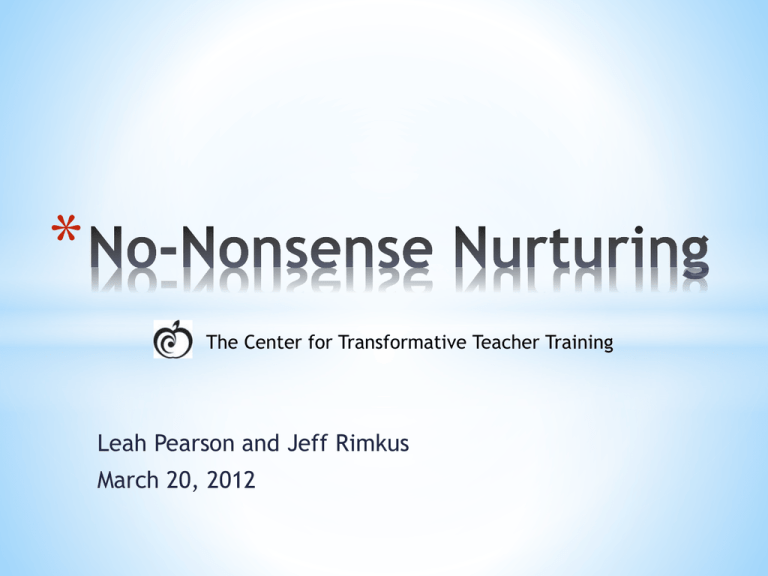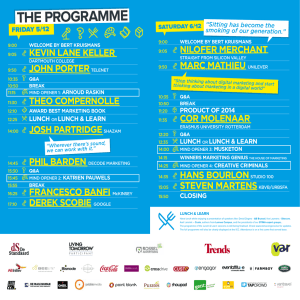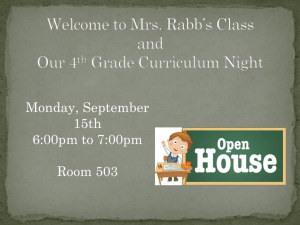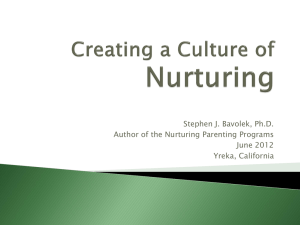No-Nonsense Nurturing
advertisement

* The Center for Transformative Teacher Training Leah Pearson and Jeff Rimkus March 20, 2012 * *To learn how to create a consistent system of classroom management that will positively affect the culture of our school CENTER FOR TRANSFORMATIVE TEACHER TRAINING * * Negative Controller No Nonsense Nurturer Unintended Enabler Turn and Talk: Draw inferences on the difference between these three types of teachers. *Allows students to engage in behavior that is not in the students’ best interest. *Motivated by being liked by students. *Makes excuses for the students’ behavior or lack of academic performance. *Heart is in the right place, but head is in the wrong place. * *Basic response is negative, angry, or sarcastic in manner. *Motivation is to maintain control at all times. Teacher’s own needs may be more important than those of their students. *They may not like their kids. * * *They make statements of fact about student behavior. *They ask rhetorical questions. *They make threats with no follow-through. *They get angry and overreact. *They engage. *What kind of classroom culture does this create? *Makes no excuses for students that are engaging in disruptive behavior. *Maintains high academic achievement expectations for all students. *Is no-nonsense in front of the class. *Nurturing in 1-1 and/or small groups. *Is culturally responsive. * *Stanford University Professor, Amado Padilla * *I earn the respect of my students. *I expect 100% engagement, 100% of the time. *I know all of my students can behave and meet expectations. *I understand the expanded role of the teacher. * *Step 1: Effectively Communicate Expectations *Step 2: Utilize Positive Narration *Step 3: Correct Off Task Disruptive Behavior *Step 4: Build Nurturing Relationships with Students * * Give precise directions related to: *Physical Movement *Verbal behavior *Participation in the activity *Attention getting signal *Check for understanding…when needed *Cue to start * *When I say go, silently and independently do the warm up on the board. Go. *When I say go, in a whisper voice, turn to your partner and share what you think the author’s message is. *When I say go, push your chair in and line up silently when your table is called. * *Video clip #1 * *Independently on note-catcher, create your 3-step directions for one of the following or a procedure from your own classroom: *Lining up for lunch *Moving to another part of the classroom *Starting your collaborative work on a math problem *Completing a sustained silent reading activity *Step 1: Effectively Communicate Expectations *Step 2: Utilize Positive Narration *Step 3: Correct Off Task Disruptive Behavior *Step 4: Build Nurturing Relationships with Students * * *Name specific behavior without praise *Narrate student(s) who followed 3-step directions *Don’t respond to students who are off task Guidelines: *Narrate immediately after giving directions *Narrate 2-3 students *Narrate BEFORE you correct *Emphasis on finding the opportunity to narrate difficult students *Narrate as often as needed-the students let you know when they need to be narrated * *Kate is silently doing the warm up on the board. *Eddie and Cynthia are talking in a whisper voice about the author’s message *Jose pushed in his chair and is silently lining up. * Benefits: *Repeats directions in a positive manner *Eliminates drawbacks of praise *Creates positive momentum * *Video clip 2 * *Based on the directions you wrote earlier, write examples of positive narration in your notecatcher. *Lining up to go to lunch *Moving to another part of your classroom *Starting your collaborative work on a math problem *Completing a sustained silent reading activity *Step 1: Effectively Communicate Expectations *Step 2: Utilize Positive Narration *Step 3: Correct Off Task Disruptive Behavior *Step 4: Build Nurturing Relationships with Students * * *Narrate 2, Correct 1 *Less talk is more effective (move in, move out, don’t engage) *Use consequences from hierarchy *Keep verbal correction quick and direct Example: 1) Student Name: Ethan 2) State Inappropriate Behavior: The direction was to do this silently. 3) Corrective Action Student Chose, if Appropriate: This is your warning. Work silently or you will choose to miss 5 min of recess. *Pause before you speak *Square up *Make eye contact *Get as close as is convenient * *Ted, the direction was to do the warm up silently. That’s a warning. You can do this, get to work silently or you will have to refocus. *Tammy and Eduardo the directions were to use level 1 voices, this is a warning. Use level 1 voices or you will be ‘last ones out.’ *Francisco, that’s a warning. The direction was to line up for lunch. I know you will follow directions or you will have a consequence. * *Video clip 3 *1st Time: Warning *2nd Time: Fill out “think sheet” for family to sign *3rd Time: Miss choice time or lunch detention *4th Time: Call family member *5th Time: Referral to * the office *1st Time: Warning *2nd Time: Afterschool/Lunch Detention *3rd Time: Call family member *4th Time: Referral to * the office *With a partner, practice correcting a student who is off task…utilize the directions you created earlier as you provide a choice for student *Lining up to go to lunch *Moving to another part of the classroom *Starting your collaborative work on a math problem *Completing a sustained silent reading activity * *Step 1: Effectively Communicate Expectations *Step 2: Utilize Positive Narration *Step 3: Correct Off Task Disruptive Behavior *Step 4: Build Nurturing Relationships with Students * * *Relationships, relationships, relationships *Earn the respect of your students. *Get to know your students . *Be authentic. *Engage in non-academic talk with students. *Have a restorative conversation after taking corrective action. *Implement class-wide reward system. *Tally marks for class points on white board. When class reaches a certain number of tally marks (depends developmentally how often) they earn: *Popcorn party (15 min max K-5) *5 minutes of ‘cha cha’ slide at end of day (kinder) *One “no homework” pass (secondary) * Note: Suggested frequency: Kinder every 3-4 days. 2nd and 3rd every week. 4th and 5th every two weeks. Middle School every 2-3 weeks. High school every month. * *“Eduardo, I know you earned a consequence today that you didn’t like. I want you to know that I believe in you and even though I have to call home tonight, I will be excited to share with your Uncle that you turned it around and followed directions the rest of the day. You can do this. I care too much about you to let you talk when you are supposed to be learning. Get back to work!” * *Restorative Conversation *Video Clip #4 *Class Wide Reward *Video Clip #5 *Break yourselves into groups of 4-5, take five minutes to discuss *Use note-catcher to record ways to build relationships with students. * *Call after a difficult day *Call when absent *Attend extracurricular activities *Have positive contact with families *Home visits * *Step 1: Effectively Communicate Expectations *Step 2: Utilize Positive Narration *Step 3: Correct Off Task Disruptive Behavior *Step 4: Build Nurturing Relationships with Students * *Think, Pair, Share * * LE 1: Demonstrates knowledge of, interest in, and respect for students’ communities and cultures. * LE 2: Fosters a supportive and respectful learning environment among students * LE 3: Motivates students to learn, take academic risks, and demonstrate classroom leadership * LE 4: Implements high, clear expectations for student behavior and responds appropriately * LE 6: Manages students, transitions, and resources effectively * Future Indicator: Implements intentional pacing * *Used consistently *Tied to Framework *Tied to other initiatives (pitted against each other) *Has majority buy-in (80%) *Is a school wide positive culture language and system * *Next NNN overview presentations (on schoolnet counts as re-cert hours) *Upcoming NNN presentation at Del Pueblo: Tuesday, March 20th 2012 * Initial studies on the use of Real Time Coaching * Teachers find the use of bug-in-the-ear feedback useful and “not distracting” (Giebelhaus, 1994; Rock et al., 2009). * Coaches find the use of bug-in-the-ear can increase their effectiveness (Rock et al., 2009). * Increase teachers’ use of positive reinforcement and improve their ability to increase student on-task behaviors (Scheeler, 2006; Rock et al., 2009). I * ncrease teachers’ use of effective instructional practices (Goodman, 2008). * I have come to a frightening conclusion. I am the decisive element in the classroom. It is my personal approach that creates the climate. It is my daily mood that makes the weather. As a teacher, I possess tremendous power to make a child’s life miserable or joyous. I can be a tool of torture or an instrument of inspiration. I can humiliate or humor, hurt or heal. In all situations, it is my response that decides whether crisis will be escalated or de-escalated, and a child is humanized or de-humanized. Interpretation of a Goethe quote * *Please fill out the feedback form on your table *








